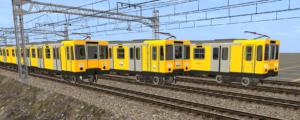
From left to right: original livery, current livery and the MCNE livery.
DOWNLOAD
All the necessary dependencies are included in the pack or are avaible on the DLS.
The M1s were designed towards the end of the 1980s in anticipation of the opening of the “Collinare Metro” in Naples (the future Line 1).
The new trains were mainly based on the best available at the time, namely the MA100 of the Rome metro, but were also subject to numerous design influences by the 500 Series “Inverter” trains of the Milan Subway; but even if compared to the previous two, the M1 Series adopted a series of new and unprecedented design solutions, such as passenger doors sliding externally to the bodyshell, a particular driving desk and above all they adopted a very particular and characteristic bogeys with brake discs external to the wheels, an unique case in Europe (atleast for subways), which gave the M1s a unique and distinctive appearance. Their GTO-VVVF inverter, produced by Ansaldo, will also be used by the MA200 Series trains of the Rome subway and the M88s of the Catania subway.
Built by a consortium of manufacturers formed by Sofer and the Fiore workshops (for the “mechanical” part: bogeys, bodyshells…) and by Ansaldo and Metalmeccanica Lucana (for the electrical part: pantographs, traction motors…), 45 2-car sets in an M-M formation (a total of 90 cars) were completed between 1991 and 1992, and trial runs began around the same time. The construction of trailer cars was not taken into consideration, as Line 1 included steep slopes, which in some sections even reached 55 ‰. The construction of an additional 10 two-car sets (20 cars) was also originally planned.
The M1s entered regular service on March 28, 1993, with the opening of the first section of Line 1, between Vanvitelli and Colli Aminei. This first section was provisionally managed by the FS (which even issued subway tickets with their own “losanga” logo). The particular situation ended in 1995, when the newly-re-founded ANM took over from FS in the management of the line.
Over the years, Line 1 was extended from both terminus in a very gradual way, and equally gradual was the entry into service of the M1 series trains, now all arranged in the standard 4-car sets: seven trains entered service in 1993, followed by three more in 1995 and so on, until the last two trains came into service, respectively in 2007 and 2008.
Around the same time, with the creation of the Metronapoli company, the livery of the M1s was changed by adding numerous company logos.
On the 16th of July 2005, the newly formed MetroCampania NordEst opened the first section of the planned Naples-Giuliano-Aversa Line, a metropolitan railway that was supposed to “replace” the Lower Alifana railway, wich had been closed in 1976. This first section was just under three kilometers in lenght and connected the stations of Piscinola-Scampia (interchange with Line 1) and Mugnano, without intermediate stops.
For a provisional shuttle operation on this short stretch of line, MCNE hired three two-car sets (a complete 4-car set for regular services and a 2-car set as spare) of the M1 Series from Metronapoli. They kept the yellow livery of Line 1, but with the application of numerous MCNE logos.
In 2009, with the opening of the rest of the line, up to Aversa Centro, and with the arrival of the second-hand MA100s from Rome, the three M1 Series trains were returned to Metronapoli.
Trivia:
Some M1 series trains were tested in Milan on the test ring track of the San Donato depot of Line 3.
